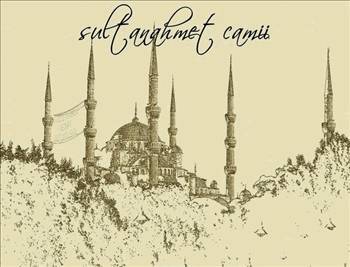|
http://worldarchivetr.com/wp/sultan-ahmet-camiinin-bilinmeyen-hikayesi/
http://www.biristanbulhayali.com/sultanahmet-camii-kapisi-ve-evliya-celebi
http://www.gbg.bonet.se/osmanli/kultur/eserler/sultanahmet.htm

Dağ gibi yüce, kuş gibi hafif
Evliya Çelebi, the great Ottoman traveller and the writer of Seyahatname, was there when the building work of Sultanahmet Mosque (the Blue Mosque) was initiated in 1609. It was an impressive moment:
Evvela Sultan Ahmed Han, eteğine toprak doldurup, ´´Ya Rab! Ahmed kulunun hizmetidir, kabul eyle´´ deyüp, amelelerle birlikte temelden toprak taşıdı.´´ Sultan Ahmed I, gathering some soil to his lap, carried the soil from the foundation together with the workers and said: ”Lord, accept the service of your slave Ahmed.”
Sedefkar Mehmed Ağa, the architect of Sultanahmet Mosque was a man of many talents. He was a musician, poet and and an artist also. In his greatest work he was able to use all sides of his artistry.
Sultanahmet Mosque was the last great mosque of the classical Ottoman period. It had to compete in beauty and majesty with both Hagia Sofia and Suleimaniye Mosque which was the masterwork of Mimar Sinan, the teacher of Mehmed Ağa.
There is a legend which says that the six minarets of Sultanahmet are actually a misunderstanding: a confusion between the Turkish words altın ‘gold’ and altı ‘six’. Who knows. Anyway, the amount of minarets caused a small scandal in the Muslim world: is Sultanahmet competing Masjid-il-Haram of Mecca? Ahmed I solved the problem by having one more minaret built in Mecca.
The Sultan was a god-fearing man:
Avlunun batı girişinde, demirden ağır bir kordon bulunmaktadır. Bu kordon, avluya atıyla giren padişahın kafasını çarpmamak için eğmesini gerektiriyordu. There is a heavy iron cord in the western gate of the mosque yard. When the Sultan entered on horseback this cord forced him to bow in order not to hit his head.
Sultanahmet Mosque has a concrete link also to our hero traveller. Next time when you enter the building from the main entrance pay attention to the door. It has been elaborated by the dervish and silversmith master Mehmed Zilli who was Evliya Çelebi´s father.
Edited (10/9/2012) by Abla
|

